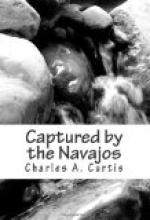Then followed the sound of steps, accompanied by voices, sounding at the entrance, as a voice spoken in a long tube appears to be uttered at the listener’s end. Some time elapsed before those who seemed so near appeared; but at last there emerged from the passage Mr. Arnold, two strange men, and three girls—but no Brenda.
“Where is Brenda, Mr. Arnold?” I asked.
“Heaven only knows, lieutenant. She gave herself up to the Apaches.”
“Gave herself up to the Apaches! What do you mean?”
“That’s precisely what she did, lieutenant,” said one of the strangers, adding: “My name is Bartlett, from Hassayampa, and this is Mr. Gilbert, from Tucson. We were on our way from La Paz to Prescott and stopped here for a meal, and got corralled by the Indians. But about the girl Brenda: she took it into her head, after we got into the little fort, that unless some one could create a diversion to mislead the devils, we’d all lose our scalps.”
“That beautiful young girl! Gave herself up to certain torture and death! Why did you allow it?”
“Allow it!” exclaimed Mr. Bartlett, indignantly. “I hope, lieutenant, you don’t think so hard of me and my friend as to believe we’d have allowed it if we’d suspected what the plucky miss meant to do!”
“Tell me the circumstances, Mr. Bartlett,” said I.
The party moved slowly along the path from the spring to the fires, and as they walked Mr. Arnold and the travellers gave an account of all that had happened after Sergeant Henry left for Fort Whipple.
The burning arrows sent to the pitch-pine roof became so numerous that the besieged found it impossible to prevent the flames from catching in several places. Henry was hardly out of sight before the house became untenable, and the defenders were obliged to retire to the fort. When the house was consumed, and its timbers had fallen into the cellar a mass of burning brands, the space about the earthwork was clear, and the rifles at its loop-holes kept the Indians close within the out-building they had occupied since the attack began. No one dared to show himself to the unerring marksmen, who watched every movement.
For a long time silence reigned among the Indians. The whites, however, felt sure that plans were being matured which meant disaster to them.
At last these plans were revealed in a constant and rapid flight of arrows, directed at a point between two loop-holes—a point which could not be reached by the besieged, and where, if a considerable collection of burning brands could be heaped against the logs, between the earth and the eaves, the pine walls and rafters must take fire. Walls and roof were too solid to be cut away, and water could not reach the outside.
The defenders, when they realized what the result of a fire would be, held a consultation, and decided that in the event of the fire getting control of the fort they should retire into the covered way, block up the entrance with earth, and remain there until help should arrive. It was thought the Indians would suppose all had perished in the flames.




